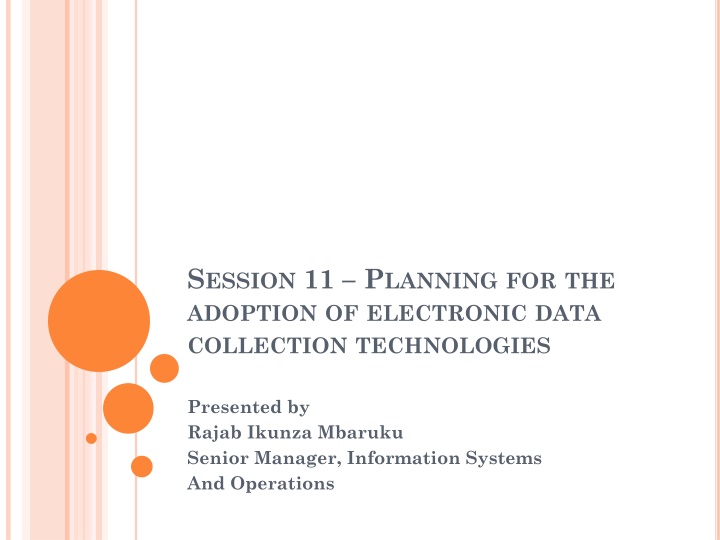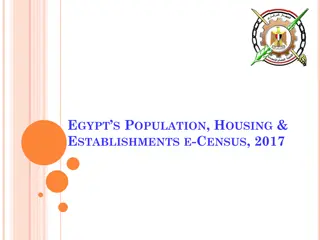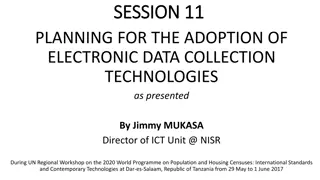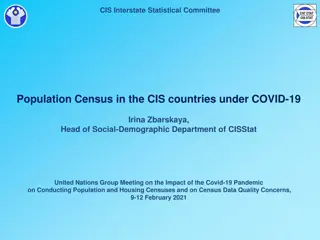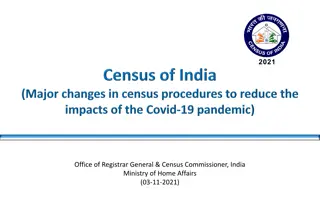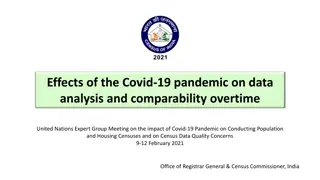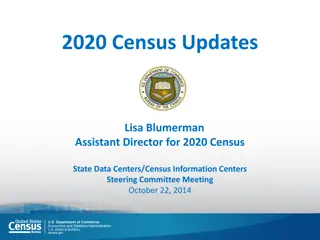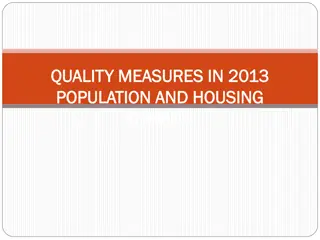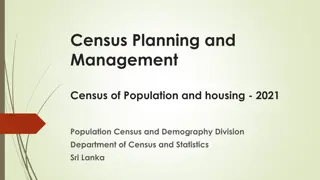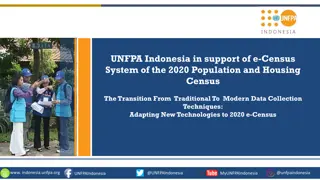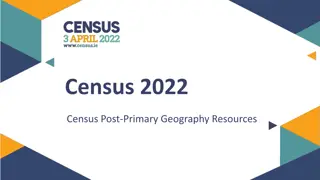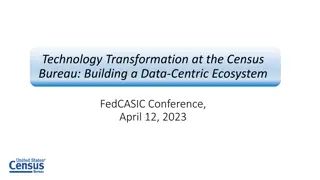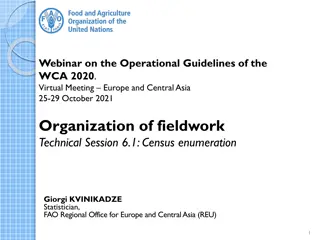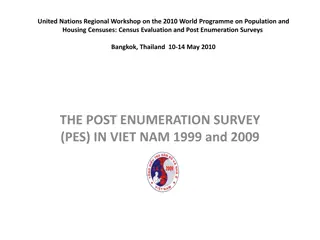Modernizing Census Operations with Electronic Data Collection Technologies
Recent technological advancements have revolutionized census processes, enhancing the efficiency and accuracy of data collection. This session delves into the strategic considerations for adopting electronic devices and mobile data capture in census operations. Insights from past experiences in Kenya's census data collection methods highlight the advantages of transitioning to digital questionnaires. Planning for the 2020 round of population and housing census involves a shift towards mobile data capture, impacting the entire census lifecycle. Key challenges and opportunities in implementing electronic data collection technologies are explored in detail.
Download Presentation

Please find below an Image/Link to download the presentation.
The content on the website is provided AS IS for your information and personal use only. It may not be sold, licensed, or shared on other websites without obtaining consent from the author.If you encounter any issues during the download, it is possible that the publisher has removed the file from their server.
You are allowed to download the files provided on this website for personal or commercial use, subject to the condition that they are used lawfully. All files are the property of their respective owners.
The content on the website is provided AS IS for your information and personal use only. It may not be sold, licensed, or shared on other websites without obtaining consent from the author.
E N D
Presentation Transcript
SESSION 11 PLANNING FOR THE ADOPTION OF ELECTRONIC DATA COLLECTION TECHNOLOGIES Presented by Rajab Ikunza Mbaruku Senior Manager, Information Systems And Operations
OUTLINE PREAMBLE REVIEW OF 2009 KPHC 2020-ROUND OF POPULATION AND HOUSING CENSUS COMPUTER-ASSISTED PERSONAL INTERVIEW KENYA DESIGN FOR MOBILE DATA COLLECTION Advantages of Using Mobile Data Capture CONSIDERATIONS FOR MOBILE DATA CAPTURE CONCLUSION
PREAMBLE Recent advances in technology have allowed national statistical organizations to innovate and modernise census processes, thereby improving the quality and timeliness of census results. The use of electronic data collection technologies along with use of geospatial technologies have substantially impacted considerations for planning, designing and implementing census operations. This session will discuss key issues that have to be taken into consideration before making a decision for the adoption of hand-held electronic devices/Internet for census data collection as well as discuss important considerations in the planning, preparation and design of census operations when using electronic data collection technologies.
REVIEW OF 2009 KPHC In the year 2009, Kenya used the scanning technology to process the paper questionnaires. Using the ICADE technology, coupled with reinforcement of questionnaires, the process running on 24-hr basis, took exactly 9 months to be completed. Another 3 months was needed to complete the analysis and the production of basic reports. Challenges in 2009 24-hr working in two shifts. The process had to be undertaken round the clock and it introduced a lot of management problems, fatigue etc Special scanner paper. The scanner would not allow just any paper to be used to print the questionnaire. The acquisition of special paper meant more cost. Reinforcement of questionnaires. We had to set up a team to undertake the re-writing the faint questionnaires for the scannners. This in itself was a potential introduction of errors Space to store the questionnaires. Noting that we had our data processing center on the 17thfloor of Nyayo House, it became a logistical nightmare to lift 18 tonnes of questionnaires. In the process, it necessitated acquisition of a warehouse 20km out of town. Questionnaires had to be brought into and out back to the warehouse.
2020-ROUND OF POPULATION AND HOUSING CENSUS As mobile technology, like tablet PCs or smartphones, become more widely available, many statistical agencies are considering using mobile data capture for the 2020 round of population and housing census data collection. Adopting mobile data capture means changing from paper-based questionnaires to electronic questionnaires and affects the entire census life cycle. This is an overview of what to consider when transitioning to mobile data capture.
COMPUTER-ASSISTED PERSONAL INTERVIEWING (CAPI) Computer-assisted personal interviewing (CAPI) is when enumerators use electronic questionnaires on laptops, tablet PCs, smartphones, or other handheld electronic devices to conduct face-to-face interviews. CAPI allows users to take advantage of added features that can be programmed into mobile devices. These include: Integrated maps and Global Positioning System (GPS). Automated skip patterns. Simultaneous process for data collection, data capture, editing, and consistency and nonresponse checks. Ability to preload questionnaire responses and customize questions.
KENYA DESIGN FOR MOBILE DATA COLLECTION
ADVANTAGES OF USING MOBILE DATA CAPTURE Improves data quality through: Logical validation rules in the questionnaire. Errors and inconsistencies may be resolved at interview time, closer to the source. More accurate progression through the questionnaire due to automated skip patterns and mandatory items. Reduced manual data entry errors. Reduced number of unlinked forms. Reduces the risk of one section of the form getting separated from the other. Improves field management and real time monitoring of enumeration activities. Reduces time and costs by eliminating a separate process for data capture, automated coding, and reducing the volume of post- enumeration data checking. Decreases time between data collection and release of the results. Reduces costs of data capture, questionnaire printing, storage, and transportation. Can utilize GPS features and digital mapping capabilities.
CONSIDERATIONS FOR ELECTRONIC DATA CAPTURE High equipment costs with limited long-term use. A census generally employs a large number of enumerators. Purchasing a mobile device for each enumerator is costly. (150,000 tablets/smartphones costing about Kshs 2.5 billion) The equipment may become obsolete quickly. (Delay the purchase until 1-year to undertaking Census) Devices may get lost, stolen, or break during the census enumeration. (Develop an ICT Policy for Use of Devices)
CONSIDERATIONS FOR ELECTRONIC DATA CAPTURE More time needed during the preparation stage. Need time for programming the application, setting up systems for data transfer and storage. (Census timetable adjustment) Requires extensive testing. (prior data collection using the technology since 2015) Needs more skilled programmers who are able to do sophisticated programming specific to the mobile device (e.g., Android) and all the necessary components of an electronic questionnaire application. (Capacity building to increase skill base)
CONSIDERATIONS FOR ELECTRONIC DATA CAPTURE Requires technologically skilled enumerators with more training and field support. Requires that enumerators can use a mobile device. (post- primary school enumerators) Requires intensive training of enumerators on use of device. Training may be more complicated than with paper questionnaires.(hands-on training using devices) Requires more technical support in the field to replace or repair devices and troubleshooting of hardware or software application problems. (ICT technical supervisors introduced)
CONSIDERATIONS FOR ELECTRONIC DATA CAPTURE Technological problems could interfere with enumeration. The battery could run out during enumeration. (power banks for each device) The equipment could break leading to data loss or lost enumeration days. (develop ICT device Policy) There are more infrastructure constraints to consider. Electricity needs to be available to charge the devices; challenging in areas with limited electricity. (portable generators) Limited Internet availability may cause difficulties in data transmission and other functions of the mobile data capture software applications that rely on the Internet. (Mobile App should be able to capture data offline ) Needs a system to transfer the data from the handheld devices in a timely and secure manner. (This could be the Internet, local area network, or through manual data transfer.) Data security must be assured during data collection, transfer, and storage. (encryption key and decryption key) Needs a system for backing up the data to prevent data loss.(cloud system, server-based systems, external storage device )
CONCLUSION Census Timetable The census timetable should be adjusted to fit the needs of implementing mobile data capture. With mobile data capture, previously separate processes may be integrated, or may need to be carried out earlier in the census life cycle. If edit checks are to be added to the application, the edit programming must be completed before the enumeration begins, rather than programming those separately in the post-enumeration stage. Further, more time should be allotted for training the enumerators since the training must include the use of the mobile devices.
CONCLUSION Budget Considerations Using an electronic questionnaire may save costs in the printing of the questionnaire and data capture, but the costs of the electronic equipment may be higher than the savings. Carefully consider all costs of conducting mobile data capture and account for them in the budget.
CONCLUSION Infrastructure Considerations Infrastructure issues such as availability of electricity and Internet access can affect the success of mobile data capture. Early in the planning stage, identify places that lack electricity and/or Internet access Mapping the areas without electricity and/ or Internet access is helpful in planning. Plans should be developed for charging and backing up the devices. It is critical to have contingency plans for when electricity and/ or Internet access are not available.
CONCLUSION Differences in Questionnaire Development Process As with a paper questionnaire, developing an electronic questionnaire is an iterative process. It must be developed, tested, revised, and then tested again, repeating the cycle until the questionnaire works as intended. Further, after the subject matter specialists finalize the questionnaire content, specifications are needed to serve as a blueprint for programmers to design the application. Adequate documentation of the questionnaire instrument is also required. In addition, an electronic questionnaire may contain additional features not included in a paper questionnaire, such as data validation and error messages. These features also must be specified so that programmers can design the application as intended. When designing an electronic questionnaire, it is critical that the subject matter specialists work closely with the programmers to make sure that there is clear communication regarding the questionnaire content, layout and design, data validation, and other specifications.
DISCUSSION Thank You
